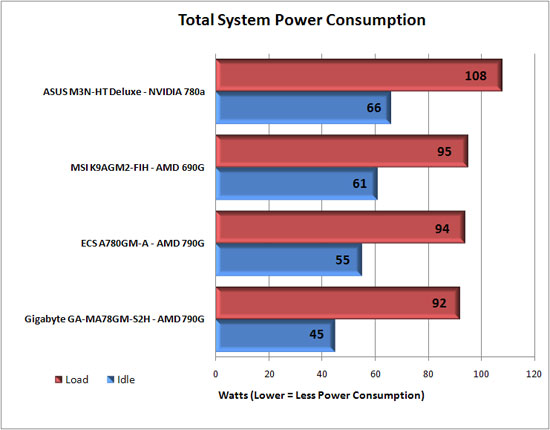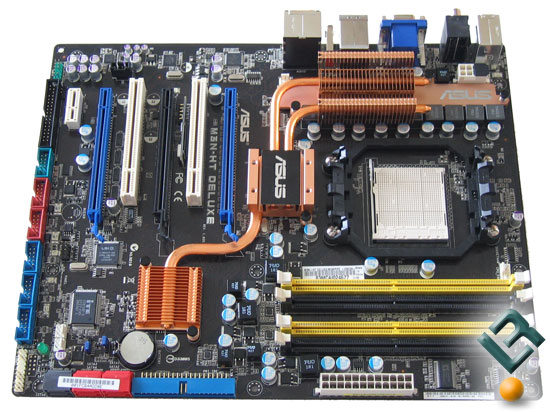NVIDIA nForce 7 Series Arrives – ASUS M3N-HT Deluxe Motherboard
Power Consumption and Conclusion
Since power consumption is a big deal these days, we ran some simple power consumption tests on our test beds. The systems ran with the power supplies, case fan, video card and hard drive model. To measure idle usage, we ran the system at idle for one hour on the desktop with no screen saver and took the measurement. For load measurements POV-Ray 3.7 was run on all cores to make sure each and every processor was at 100% load. All of the systems used identical hardware minus the motherboard and processor.

Results: The ASUS M3N-HT Deluxe used the most power and C’N’Q was enabled! Keep in mind that the ASUS M3N-HT Deluxe is a full sized ATX motherboard and all the rest are micro-ATX motherboards.

Final Thoughts and Conclusions:
The NVIDIA nForce 780a SLI chipset has a ton of things to look at, and while we’ve spent days benchmarking it and trying various processors on it, we still have only scratched the surface of what the board is fully capable of. ASUS and NVIDIA has informed us that a new BIOS that improves performance is coming out the day of the launch, so we didn’t want to spend more time benchmarking the new platform as it won’t mean anything the day after this article is posted. Amazing how 20 hours of benchmarking and tinkering is dated before anyone really gets to read about it.
The nForce 7 series is late to the game when it comes to integrated graphics, but this motherboard is aimed at the enthusiast/gamer market and not the entry level consumers. We compared the nForce 780a SLI to the AMD 780G since we wanted to test out the integrated graphics and PureVideo HD functionality as well as general performance. It seems to have paid off; the test results were interesting as the HD DVD playback testing over the HDMI output showed that NVIDIA passed up ATI when it comes to offloading the CPU usage. NVIDIA claims that an HT3-based Phenom CPU is required to provide the necessary bandwidth when playing HD video using the motherboard GPU. Our testing showed this is not true, but NVIDIA claims moving from a HT1 processor to HT3 will give the integrated graphics the bandwidth it needs to better render HD content. This is something we will check out later, because if we are impressed with what a 2.5GHz AMD Athlon 64 X2 dual-core CPU can do with HT1, we’d better be sitting down for some Phenom action.
Other than HD DVD playback, our testing showed that the AMD 780G has slightly stronger integrated graphics, but for the most part the nForce 780a SLI chipset is hanging close. If it weren’t for the slightly lower gaming scores in S.T.A.L.K.E.R. and World in Conflict, the nForce 780a would have put a pretty good spanking on the AMD 790G platforms we compared it to. The nForce 780a SLI chipset is also ideal if you are looking for RAID 5 support as the current AMD 780G/SB700 boards don’t support it (AMD is working on a new south bridge called the SB750 that will). The nForce 7 series supports massive RAID 5 arrays right out of the box.
Overclocking on the ASUS M3N-HT Deluxe motherboard was a breeze and the few BIOS issues we encountered should be cleared up by a new BIOS that should be released to reviewers by the time you are reading this. The NVIDIA nForce 7 series seems to be a step in the right direction and all the new features are almost overwhelming.
The only drawback that we found with the nForce 780a SLI chipset is the fact that it supports 3-way SLI, but only has a single-link DVI output. This means the maximum resolution is 19201200 when a monitor is connected to the integrated graphics. Not many people run 3-way SLI and have 30″ monitors than run at a native resolution of 2560×1600, but for those that want the ultimate platform they will want to run at the right resolution.
With a platform like this, one can expect it to be pricey, and it is a tad expensive. ASUS informed us that the M3N-HT Deluxe motherboard that we looked at today has an MSRP of $249.99. The most expensive AMD processor is the AMD Phenom X4 9850 Quad-Core and it is just $235.00! No matter what AMD chipsets come out they still can’t offer the price versus performance value that Intel platforms can.
Update: After taking a futher look at the features of this board it was given the innovation award!

Legit Bottom Line: The NVIDIA nForce 7 series shows the world that NVIDIA is finally back on the AMD side of things. More importantly, it shows what is coming out in Q3 for the Intel platforms and we can only assume that any issues with Hybrid technology will be perfected before the Intel series comes out.

Comments are closed.